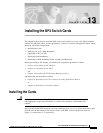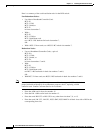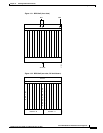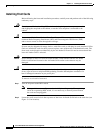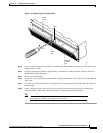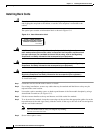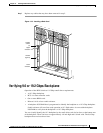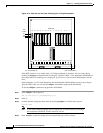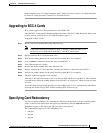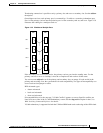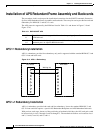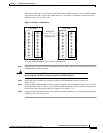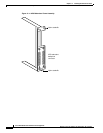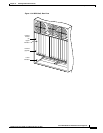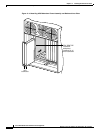
13-9
Cisco BPX 8600 Series Installation and Configuration
Release 9.3.10, Part Number 78-11603-01 Rev. D0, July 2001
Chapter 13 Installing the BPX Switch Cards
Upgrading to BCC-4 Cards
If the backplane is not a 19.2 Gbps backplane, then it will be necessary to install a 19.2 Gbps backplane
to obtain 19.2 Gbps operation. Contact Cisco Customer Service.
Upgrading to BCC-4 Cards
BCC-4 cards support 19.2 Gbps performance of the BXM cards.
Note that BCC-4 cards requires that the backplane be either a 9.6 or 19.2 Gbps backplane. Refer to the
previous section, Verifying 9.6 or 19.2 Gbps Backplane, page 13-7.
To upgrade to BCC-4 cards:
Step 1 Remove the current standby BCC front and back card.
Note If the control card being replaced is a BCC-3, the BCC-3 backcard (BCC-3-bc)
canbeusedasitisusedwithboththeBCC-3andBCC-4frontcards.
Step 2 Replace with new BCC-4 front and back cards.
Step 3 Wait for the standby updates on the newly installed standby BCC-4 to complete.
Step 4 Issue a switchcc command to utilize the newly installed BCC-4.
Step 5 Verify that the network is stable.
Step 6 Remove the current standby BCC front and back card.
Step 7 Replace with new BCC-4 front and back cards that are identical to the current active BCC-4.
Step 8 Wait for the standby updates on the newly installed standby BCC-4 to complete.
Step 9 The BCC-4 physical upgrade is now complete.
After step 2, the node will contain a mix of an old type BCC and the new type BCC-4. This condition
is permitted only while the standby updates to the new BCC are in progress, which will take less than
one hour.
You should keep the time during which this mixture of BCC types exists to a minimum by immediately
replacing the second old type BCC with the matching BCC of the new type.
Specifying Card Redundancy
You can set up port redundancy by installing two identical front and back card sets, connecting them
with a Y-cable on each paired port, then specifying redundancy with the addyred command.
Redundancy applies to the entire card and is not port or line-specific.
The commands that apply to Y-cable redundancy are:
• addyred
• delyred
• dspyred



